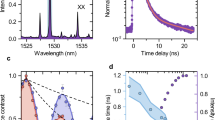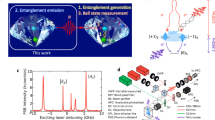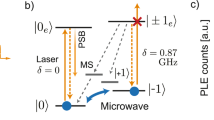Abstract
Long-distance quantum teleportation and quantum repeater technologies require entanglement between a single matter quantum bit (qubit) and a telecommunications (telecom)-wavelength photonic qubit1,2,3,4,5. Electron spins in III–V semiconductor quantum dots are among the matter qubits that allow for the fastest spin manipulation6,7 and photon emission8,9, but entanglement between a single quantum-dot spin qubit and a flying (propagating) photonic qubit has yet to be demonstrated. Moreover, many quantum dots emit single photons at visible to near-infrared wavelengths, where silica fibre losses are so high that long-distance quantum communication protocols become difficult to implement10. Here we demonstrate entanglement between an InAs quantum-dot electron spin qubit and a photonic qubit, by frequency downconversion of a spontaneously emitted photon from a singly charged quantum dot to a wavelength of 1,560 nanometres. The use of sub-10-picosecond pulses at a wavelength of 2.2 micrometres in the frequency downconversion process provides the necessary quantum erasure to eliminate which-path information in the photon energy. Together with previously demonstrated indistinguishable single-photon emission at high repetition rates11,12, the present technique advances the III–V semiconductor quantum-dot spin system as a promising platform for long-distance quantum communication.
This is a preview of subscription content, access via your institution
Access options
Subscribe to this journal
Receive 51 print issues and online access
$199.00 per year
only $3.90 per issue
Buy this article
- Purchase on Springer Link
- Instant access to full article PDF
Prices may be subject to local taxes which are calculated during checkout




Similar content being viewed by others
References
Kimble, H. J. The quantum internet. Nature 453, 1023–1030 (2008)
Ritter, S. et al. An elementary quantum network of single atoms in optical cavities. Nature 484, 195–200 (2012)
Togan, E. et al. Quantum entanglement between an optical photon and a solid-state spin qubit. Nature 466, 730–734 (2010)
Blinov, B. B., Moehring, D. L., Duan, L.-M. & Monroe, C. Observation of entanglement between a single trapped atom and a single photon. Nature 428, 153–157 (2004)
Wilk, T., Webster, S. C., Kuhn, A. & Rempe, G. Single-atom single-photon quantum interface. Science 317, 488–490 (2007)
Press, D., Ladd, T. D., Zhang, B. & Yamamoto, Y. Complete quantum control of a single quantum dot spin using ultrafast optical pulses. Nature 456, 218–221 (2008)
Press, D. et al. Ultrafast optical spin echo in a single quantum dot. Nature Photon. 4, 367–370 (2010)
Pelton, M. et al. Efficient source of single photons: a single quantum dot in a micropost microcavity. Phys. Rev. Lett. 89, 233602 (2002)
Moreau, E. et al. A single-mode solid-state source of single photons based on isolated quantum dots in a micropillar. Physica E 13, 418–422 (2002)
Takesue, H. et al. Quantum key distribution over a 40-dB channel loss using superconducting single-photon detectors. Nature Photon. 1, 343–348 (2007)
Santori, C., Fattal, D., Vuckovic, J., Solomon, G. S. & Yamamoto, Y. Indistinguishable photons from a single-photon device. Nature 419, 594–597 (2002)
Patel, R. B. et al. Two-photon interference of the emission from electrically tunable remote quantum dots. Nature Photon. 4, 632–635 (2010)
Duan, L.-M., Lukin, M. D., Cirac, J. I. & Zoller, P. Long-distance quantum communication with atomic ensembles and linear optics. Nature 414, 413–418 (2001)
Briegel, H.-J., Dür, W., Cirac, J. I. & Zoller, P. Quantum repeaters: the role of imperfect local operations in quantum communication. Phys. Rev. Lett. 81, 5932–5935 (1998)
Yuan, Z.-S. et al. Experimental demonstration of a BDCZ quantum repeater node. Nature 454, 1098–1101 (2008)
Stute, A. et al. Tunable ion-photon entanglement in an optical cavity. Nature 485, 482–485 (2012)
Moehring, D. L. et al. Entanglement of single-atom quantum bits at a distance. Nature 449, 68–71 (2007)
Chou, C. W. et al. Measurement-induced entanglement for excitation stored in remote atomic ensembles. Nature 438, 828–832 (2005)
Faraon, A., Barclay, P. E., Santori, C., Fu, K.-M. C. & Beausoleil, R. G. Resonant enhancement of the zero-phonon emission from a colour centre in a diamond cavity. Nature Photon. 5, 301–305 (2011)
Michler, P. et al. A quantum dot single-photon turnstile device. Science 290, 2282–2285 (2000)
Santori, C., Pelton, M., Solomon, G., Dale, Y. & Yamamoto, Y. Triggered single photons from a quantum dot. Phys. Rev. Lett. 86, 1502–1505 (2001)
Kim, D., Carter, S. G., Greilich, A., Bracker, A. S. & Gammon, D. Ultrafast optical control of entanglement between two quantum-dot spins. Nature Phys. 7, 223–229 (2011)
Pelc, J. S., Langrock, C., Zhang, Q. & Fejer, M. M. Influence of domain disorder on parametric noise in quasi-phase-matched quantum frequency converters. Opt. Lett. 35, 2804–2806 (2010)
Bayer, M. et al. Fine structure of neutral and charged excitons in self-assembled In(Ga)As/(Al)GaAs quantum dots. Phys. Rev. B 65, 195315 (2002)
Xu, X. et al. Fast spin state initialization in a singly charged InAs-GaAs quantum dot by optical cooling. Phys. Rev. Lett. 99, 097401 (2007)
Xu, X. et al. Optically controlled locking of the nuclear field via coherent dark-state spectroscopy. Nature 459, 1105–1109 (2009)
Scully, M. O. & Drühl, K. Quantum eraser: a proposed photon correlation experiment concerning observation and “delayed choice” in quantum mechanics. Phys. Rev. A 25, 2208–2213 (1982)
Tanner, M. G. et al. Enhanced telecom wavelength single-photon detection with NbTiN superconducting nanowires on oxidized silicon. Appl. Phys. Lett. 96, 221109 (2010)
Nielsen, M. A. & Chuang, I. L. Quantum Computation and Quantum Information (Cambridge Univ. Press, 2000)
Gao, W. B., Fallahi, P., Togan, E., Miguel-Sanchez, J. & Imamoglu, A. Observation of entanglement between a quantum dot spin and a single photon. Naturehttp://dx.doi.org/10.1038/nature11573 (this issue)
Acknowledgements
We thank D. Press, T. Ladd, D. Sleiter, S. Tawfeeq, S. Rumley, D. Werthimer, A. Langman, C. Langrock, Q. Zhang, N. Namekata, S. Inoue, T. Inagaki and H. Kosaka for discussions, comments and technical assistance. We thank V. Zwiller and S. Dorenbos (TU Delft) for providing the superconducting detector samples used. This work was supported by the JSPS through its FIRST programme, NICT, NSF CCR-08 29694, NIST 60NANB9D9170, Special Coordination Funds for Promoting Science and Technology, and the State of Bavaria. J.S.P. and M.M.F. were supported by the United States AFOSR (grant FA9550-12-1-0110). Other authors were supported as follows: K.D.G. by a Herb and Jane Dwight Stanford Graduate Fellowship; P.L.M. by a David Cheriton Stanford Graduate Fellowship; J.S.P. by a Robert N. Noyce Stanford Graduate Fellowship; C.M.N. by a SU2P Entrepreneurial Fellowship; and R.H.H. by a Royal Society University Research Fellowship.
Author information
Authors and Affiliations
Contributions
S.M., C.S., M.K. and S.H. grew and fabricated the samples. K.D.G. and Y.Y. designed the experiment. K.D.G., J.S.P., L.Y., P.L.M., C.M.N. and N.Y.K. performed the optical experiments. J.S.P. designed and fabricated the PPLN waveguides. J.S.P. and L.Y. developed the 2.2-µm set-up and the 1,560-nm filtering design. C.M.N. and R.H.H. packaged, characterized and implemented the SNSPD detectors. Y.Y., M.M.F., E.A. and A.F. guided the work. K.D.G. wrote the manuscript with input from all authors.
Corresponding author
Ethics declarations
Competing interests
The authors declare no competing financial interests.
Supplementary information
Supplementary Information
This file contains Supplementary Text and Data 1-6, Supplementary Figures 1-11 and additional references. (PDF 613 kb)
Rights and permissions
About this article
Cite this article
De Greve, K., Yu, L., McMahon, P. et al. Quantum-dot spin–photon entanglement via frequency downconversion to telecom wavelength. Nature 491, 421–425 (2012). https://doi.org/10.1038/nature11577
Received:
Accepted:
Published:
Issue Date:
DOI: https://doi.org/10.1038/nature11577
This article is cited by
-
Configurable circular-polarization-dependent optoelectronic silent state for ultrahigh light ellipticity discrimination
Light: Science & Applications (2023)
-
Indistinguishable telecom band photons from a single Er ion in the solid state
Nature (2023)
-
Telecom-band quantum dot technologies for long-distance quantum networks
Nature Nanotechnology (2023)
-
High-rate entanglement between a semiconductor spin and indistinguishable photons
Nature Photonics (2023)
-
Ideal refocusing of an optically active spin qubit under strong hyperfine interactions
Nature Nanotechnology (2023)
Comments
By submitting a comment you agree to abide by our Terms and Community Guidelines. If you find something abusive or that does not comply with our terms or guidelines please flag it as inappropriate.



